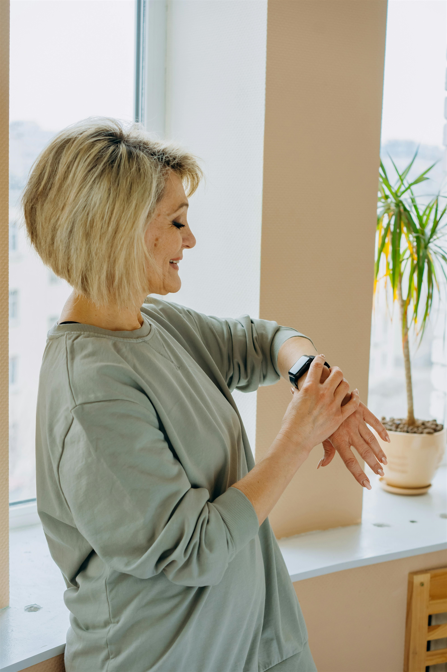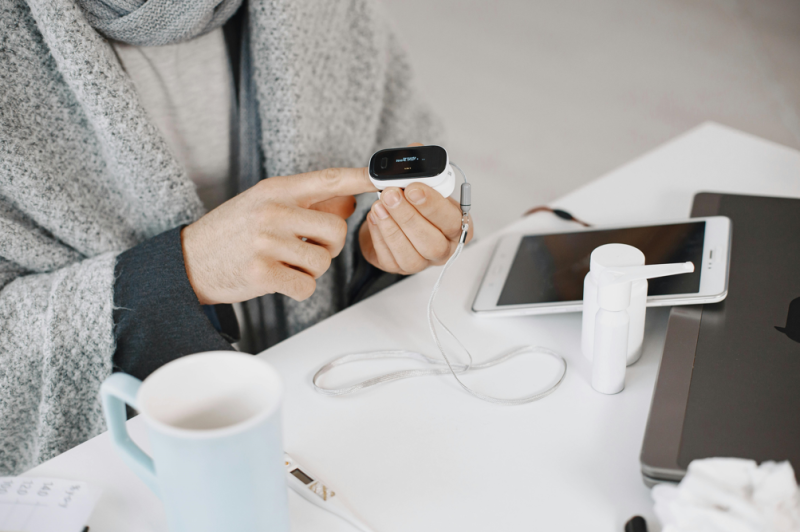As healthcare systems worldwide embrace digital transformation, the NHS faces growing pressures from an aging population, a rise in chronic conditions, and workforce constraints. Wearable health technologies, such as smartwatches, fitness trackers, and medical-grade devices, enable real-time monitoring, support remote care, and facilitate a shift toward preventive and patient-centric healthcare. Thus, directly aligning with the government’s strategic focus on community-based care, digital transformation, and prevention. In this article, we explore how wearable health tech can be used to reshape healthcare delivery, look at best practice examples, and examine the challenges and enablers for the NHS.
Wearables in the NHS: Supporting a Shift in Healthcare Priorities
To address escalating healthcare demands and resource challenges, the government’s agenda emphasises three essential shifts: moving from hospital-based to community-based care, embracing digital health solutions, and prioritising prevention. Wearable health technology plays a crucial role in achieving these goals:
1. From Hospital to Community: Enabling Remote, Ongoing Care
Devices such as continuous glucose monitors and blood pressure trackers enable patients to monitor their conditions outside the hospital. For chronic issues such as diabetes, hypertension, and heart disease, these devices provide real-time data which help healthcare professionals intervene early, reducing frequent and costly hospital visits. This technology can allow patients to monitor their health from home, freeing up beds and reducing deconditioning that can occur in hospitals. This shift toward remote management supports the NHS’s community-based care model, making healthcare more accessible and cost-effective.
2. From Analogue to Digital: Enhancing Digital Care Pathways with Real-Time Data
Devices such as the Apple Watch and Fitbit track essential metrics including heart rate, oxygen levels, and physical activity. By integrating these continuous data streams into digital health records, clinicians gain a comprehensive, real-time picture of each patient’s health status, supporting faster and more tailored decision-making. In addition, AI-driven analytics can then identify trends and risk factors earlier, positioning wearables as integral to the NHS’s digital care transformation.
3. Sickness to Prevention: Empowering Proactive, Preventive Care
Wearables put individuals in control of their health by monitoring daily metrics such as sleep quality, heart rate variability, and physical activity. With early detection of conditions such as arrhythmias or sleep disorders, wearables prompt timely medical attention and may save lives. This shift toward lifestyle-based prevention empowers individuals to make proactive changes to avoid chronic diseases, aligning closely with the Labour government’s objective to reduce the NHS’s chronic disease burden.
Benefits of Wearables in the NHS
Integrating wearable technology into NHS patient care offers several key advantages:
- Improved Patient Monitoring: Continuous real-time monitoring enables healthcare professionals to identify potential health issues before they escalate, supporting early intervention and better health outcomes.
- Personalised Care: Wearables provide individualised health data, enabling more tailored treatment plans that cater to each patient’s unique health needs.
- Enhanced Patient Engagement and Self-Care: By offering real-time insights into their health, wearables encourage patients to actively manage their conditions and adhere to treatment regimens, fostering a more engaged approach to personal health.
- Early Detection and Prevention: Leveraging machine learning, AI algorithms can analyse wearable data to detect patterns or anomalies, supporting proactive health management and early identification of potential issues.
- Reduced Hospital Admissions: With the ability to monitor patients remotely, wearables decrease the need for hospital visits, allowing patients to receive care and recover at home and easing pressure on NHS resources.
Challenges and Enablers
To fully harness wearable health technology, the NHS must overcome key challenges and build on enablers which support its integration:
Data Privacy and Security: Establishing robust guidelines for data consent and protection is critical. This requires collaboration among technology providers, healthcare professionals, and regulatory bodies to create standards that safeguard patient data while enabling seamless AI and wearable integration. Security measures should include data encryption, secure authentication, and regular security audits.
Key Question: How can the NHS ensure patient data from wearables is safeguarded across multiple platforms, given the potential complexity of AI and wearable integration?
Infrastructure and Interoperability: For wearable data to be useful, it must integrate smoothly with Electronic Patient Records (EPRs), shared care records, and platforms like the NHS App. This requires standardised information standards, cross-system collaboration, and an enabling environment, including funding, skills training, and governance.
Key Question: How can the NHS foster cross-system collaboration among healthcare providers, technology vendors, and regulatory bodies to create a unified infrastructure for wearable data?
Level of Care: While wearable technology enables continuous remote monitoring, it may risk creating a “stand-off” style of care that feels impersonal to patients. Reduced face-to-face interaction may lead some patients, especially those with chronic or serious health issues, to feel their conditions are not being taken seriously. To prevent resistance, a shift in both patient and provider education is needed. It is imperative that innovative solutions like wearables are recognized as serious, effective forms of care equivalent to the hospital-level of monitoring.
Key Question: How can the NHS ensure that remote monitoring with wearables maintains a personal and empathetic approach to patient care, especially for those with chronic conditions?
Ensuring Equitable Access: The NHS must ensure wearable health technology is accessible to all patients, regardless of socioeconomic status, to prevent widening healthcare disparities. Without equitable access, only certain populations will benefit from the enhanced monitoring and preventive care that wearables offer. Health outcomes from wearables rely on users’ ability to act on insights, which may be constrained by economic, social, or environmental factors, such as access to safe exercise spaces, nutritious food, or stable housing. Inclusive policies and resources are essential to ensure wearable technology benefits all patients; and reduces, rather than increases health inequities.
Key Question: How can the NHS address the social and environmental barriers that may limit the effectiveness of wearable insights for certain populations?
Enabling Greater Patient Engagement: Wearables give individuals more control over their health, supporting proactive monitoring. For example, devices like the WHOOP band track metrics, such as Heart Rate Variability (HRV), offering insights into recovery, sleep quality, and stress levels. By enabling informed choices, wearables can encourage self-accountability and can positively impact public health across the UK. Collaborative service design, focusing on digital inclusion, user satisfaction, and confidence-building, will be needed to ensure patients are empowered and promote shared responsibility for health outcomes.
Key Question: How can wearables be design to encourage long-term engagement and self-accountability among patients?
Enhanced Analytics and AI Integration: AI-driven wearable technology promises faster, more accurate diagnoses and better patient outcomes. Companies like Sanius Health are pioneering this space, as shown in the NHS case studies. However, integrating wearable data into patient care introduces new complexities for clinicians, adding to their workload. This integration will require staff training, access to an analytics and data science workforce, and sufficient capacity for transformation—supported by a robust, real-time change management approach.
Key Question: How can the NHS balance the benefits of AI-driven insights from wearable data with the increased workload and complexity it introduced for clinicians?
Case Studies: Learning from NHS and International Success
1. NHS Case Studies: Wearables in Chronic and Rare Condition Management
A. Predicting Vaso-Occlusive Crises with Sanius Health:
Sickle cell disease (SCD) is a genetic blood disorder primarily affecting individuals of African, Caribbean, and Middle Eastern descent. This chronic condition can lead to vaso-occlusive crises. Here, rigid, sickle-shaped red blood cells block blood vessels leading symptoms such as intense pain, shortness of breath and chest pain. Sanius Health’s wearable-powered algorithms help predict these crises by tracking real-time metrics like oxygen levels, pain, and activity. This proactive monitoring enables NHS clinicians to intervene early, reducing emergency visits, hospital admissions, and improving overall patient outcomes.
B. Supporting Chronic Conditions with Remote Monitoring:
The NHS’s collaboration with Sanius Health is also enhancing chronic disease management through continuous monitoring. By remotely tracking key health metrics—such as blood glucose for diabetes, heart rate for cardiovascular conditions, and oxygen saturations alongside respiratory rate for COPD—clinicians can intervene earlier. This approach has reduced emergency admissions by up to 52% and decreased hospital stays by 53%. This again aligns with the Labour Government’s focus on community-based care, supporting NHS efforts to improve outcomes and empower patient self-management for chronic and rare conditions.
2. Global Case Studies: Learning from International Success
A. Japan: Wearables for an Aging Population: With one of the world’s oldest populations, Japan uses wearables like the Fujitsu Device for Elderly Care to monitor heart rates, body temperature, and physical activity in nursing homes, allowing caregivers to respond quickly to emergencies. This program has reduced emergency hospital visits, alleviating hospital pressures and improving eldercare quality.
B. United States: Veterans Health Administration (VHA) Remote Monitoring: The VHA in the U.S. provides veterans with chronic conditions such as diabetes and COPD with wearables to track vital signs remotely. This initiative has led to a 25% reduction in hospital readmissions and improved chronic disease management, highlighting the effectiveness of remote monitoring in reducing hospital reliance.
C. Finland: Population Health and Stress Monitoring with Oura Ring: During the COVID-19 pandemic, Finland’s Institute for Health and Welfare partnered with Oura to track population health trends through wearables that monitor sleep, body temperature, and stress levels. This initiative demonstrated how wearables can support public health as well as individual health monitoring.
D. Norway: Mental Health Support with SINTEF: Norway’s SINTEF project uses wearables to monitor physiological indicators of anxiety and depression, such as heart rate variability. Paired with mobile apps offering real-time feedback and coping strategies, this initiative enables early intervention and supports self-management, reducing the need for hospital-based mental health care.
Conclusion
Wearable health technology has the potential to help transform healthcare delivery within the NHS, from enabling remote monitoring to promoting preventive care. These devices can support the NHS in providing more personalised, efficient, and cost-effective services.
However, overcoming challenges such as data privacy, interoperability, patient engagement, equitable access, and AI integration will be essential for successful adoption.
By learning from international case studies and investing in digital innovation, the NHS can harness the power of wearable health tech to improve patient outcomes and drive healthcare transformation across the UK.
References
- Fujitsu. “Wearable Devices in Elderly Care: Reducing Emergency Visits.”
- Veterans Health Administration. “Remote Monitoring Success in Chronic Disease Management.”
- TeleCare North Project, Denmark. “Wearables in COPD Care.”
- Finnish Institute for Health and Welfare (THL). “Oura Ring and Population Health Monitoring.”
- SINTEF. “Wearables for Mental Health: Real-Time Feedback in Anxiety Management.”
- Sanius Health. Translating Real-World Wearables and Digital Self-Reporting Data to Novel Research Insights: Vaso-Occlusive Crisis Predictions and Treatment Pathway Insights in Sickle Cell Disease.
- Health Tech News (HTN). Wearable Tech in the NHS’s Next Phase of Healthcare Outcomes Acceleration: Supporting Patients with Rare and Chronic Conditions.
- The Lancet Digital Health study on wearables and activity levels: https://www.thelancet.com/journals/landig/home


